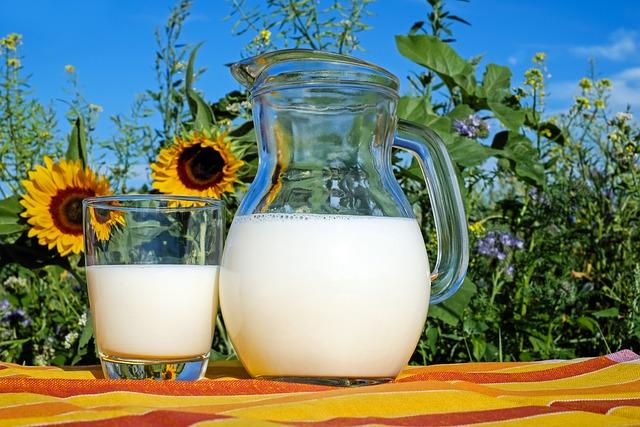In the world of nutrition, where kale smoothies and chia seed puddings often take center stage, a quiet yet spirited debate has been simmering beneath the surface: the battle of whole milk versus skim. At first glance, the choice between these two dairy contenders may seem as straightforward as the splash of white they add to your morning coffee. Yet, beneath their creamy or lean exteriors lies a complex interplay of health benefits and dietary considerations that has captivated nutritionists, dietitians, and everyday milk drinkers alike. As we delve into this creamy conundrum, we’ll explore the nutritional nuances, weigh the health claims, and ultimately seek to answer a deceptively simple question: Is whole milk truly healthier than its skim counterpart? Join us on this milky journey as we pour over the facts and sift through the myths, all in the quest for dairy enlightenment.
Nutritional Face-off Whole Milk vs Skim
When it comes to choosing between whole milk and skim milk, the nutritional differences can be quite significant, yet subtle. Whole milk, with its creamy texture, contains about 3.5% fat, offering a richer taste and a more satiating experience. It provides essential vitamins such as vitamin D and vitamin A, which are fat-soluble and more readily absorbed in the presence of fat. However, this also means a higher calorie count, which can be a concern for those watching their caloric intake.
On the other hand, skim milk is stripped of its fat content, resulting in a lighter taste profile and a lower calorie count. This makes it a popular choice for those looking to reduce their fat intake while still benefiting from the calcium and protein that milk provides. However, the removal of fat can also mean a reduction in flavor and a lesser absorption of fat-soluble vitamins unless they are fortified back into the milk. Key considerations include:
- Caloric Content: Whole milk is higher in calories compared to skim.
- Fat Content: Skim milk is virtually fat-free, while whole milk contains around 8 grams of fat per cup.
- Vitamin Absorption: Whole milk naturally supports better absorption of fat-soluble vitamins.
- Taste and Texture: Whole milk offers a creamier texture, whereas skim milk is lighter.

Understanding the Fat Content and Its Impact on Health
When choosing between whole milk and skim milk, understanding the fat content and its implications on health can guide you toward a more informed decision. Whole milk contains approximately 3.25% fat, which contributes to its rich and creamy texture. This fat content not only enhances flavor but also aids in the absorption of fat-soluble vitamins such as A, D, E, and K. In contrast, skim milk is virtually fat-free, offering a lighter alternative for those looking to reduce their calorie and saturated fat intake.
Benefits of Whole Milk:
- Richer in taste and texture
- Supports the absorption of fat-soluble vitamins
- May provide a more satisfying feeling of fullness
Benefits of Skim Milk:
- Lower in calories and saturated fat
- Suitable for those on a low-fat diet
- Can be a better option for weight management
Ultimately, the choice between whole and skim milk should align with individual dietary needs and health goals. While whole milk may appeal to those seeking a more nutrient-dense option, skim milk could be advantageous for those focused on reducing fat intake.

Calcium and Vitamins Decoding the Nutritional Benefits
When considering the nutritional benefits of milk, it’s essential to look beyond just the fat content and delve into the rich tapestry of calcium and vitamins each type offers. Both whole and skim milk are excellent sources of calcium, which is crucial for maintaining strong bones and teeth. Additionally, milk is fortified with vitamins such as A and D, which play vital roles in supporting vision, immune function, and bone health.
- Whole Milk: Offers a more complete vitamin profile, including natural vitamin A, which is sometimes reduced in skim milk due to the removal of fat.
- Skim Milk: Often fortified to match the vitamin levels of whole milk, ensuring it remains a viable option for those monitoring their fat intake.
In choosing between whole and skim, consider personal dietary needs and preferences. Both varieties provide essential nutrients, but the presence of fats in whole milk aids in the absorption of fat-soluble vitamins, potentially offering a more balanced nutritional intake.

Making the Right Choice Tailoring Milk Selection to Your Lifestyle
Choosing between whole milk and skim can seem like a nutritional crossroads. Whole milk is known for its creamy texture and rich taste, offering a full-bodied experience that’s hard to beat. It contains more calories and fat, which can be beneficial for those needing extra energy or fat-soluble vitamins. On the other hand, skim milk provides a leaner option, with fewer calories and no fat, making it appealing to those focused on weight management or reducing fat intake.
- Caloric Content: Whole milk is higher in calories compared to skim milk, making it a better choice for those who need to increase their calorie intake.
- Fat Content: Whole milk provides essential fatty acids and fat-soluble vitamins like A and D, while skim milk offers these vitamins through fortification.
- Taste and Texture: If you prefer a creamier texture, whole milk might be your go-to, whereas skim milk is ideal for those who enjoy a lighter taste.
- Dietary Goals: Consider your personal health goals; whole milk can support growth and energy needs, while skim can aid in calorie and fat reduction.
Ultimately, the decision hinges on individual lifestyle and nutritional needs. Whether you lean towards the richness of whole milk or the lightness of skim, both options can fit into a balanced diet.
To Conclude
In the swirling debate over whether whole milk or skim milk reigns supreme in the realm of health, the answer remains as nuanced as the flavors themselves. As we journey through the milky way of nutritional science, it’s clear that both options have their merits and potential drawbacks. Whole milk offers a creamy embrace of natural fats, possibly bestowing satiety and a fuller flavor, while skim milk presents a lighter, leaner alternative, often favored by those seeking to trim calories. Yet, the choice between whole and skim may well depend on individual health goals, dietary preferences, and personal tastes. So, as you stand in the dairy aisle, contemplating your next pour, remember that the key to health often lies in balance and moderation. Whether you choose the richness of whole milk or the subtlety of skim, let it be a decision that complements your lifestyle and nourishes your well-being. After all, in the grand tapestry of nutrition, it is the diversity of choices that enriches our lives and sustains our bodies.


































